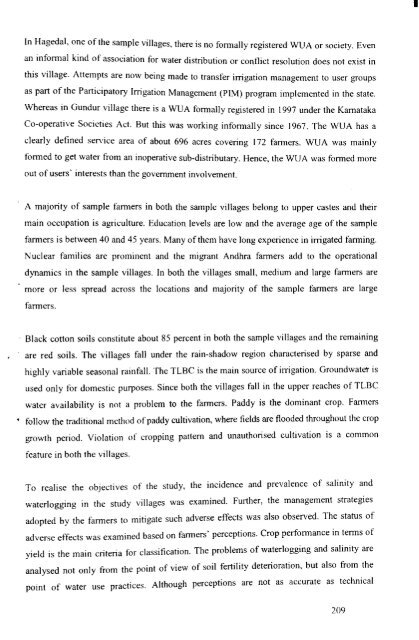Water Users Association and Irrigation Management - Institute for ...
Water Users Association and Irrigation Management - Institute for ...
Water Users Association and Irrigation Management - Institute for ...
You also want an ePaper? Increase the reach of your titles
YUMPU automatically turns print PDFs into web optimized ePapers that Google loves.
I<br />
In Hagedal, one of the sample villages, there is no <strong>for</strong>mally registered WUA or society. Even<br />
an in<strong>for</strong>mal kind of association <strong>for</strong> water distribution or conflict resolution does not exist in<br />
this village. Attempts are now being made to transfer irrigation management to user groups<br />
as part of the Participatory <strong>Irrigation</strong> <strong>Management</strong> (PIM) program implemented in the state.<br />
Whereas in Gundur village there is a WUA <strong>for</strong>mally registered in 1997 under the Kamataka<br />
Co-operative Societies Act. But this was working in<strong>for</strong>mally since 1967. The WUA has a<br />
clearly defined service area of about 696 acres covering 172 farmers. WUA was mainly<br />
<strong>for</strong>med to get water from an inoperative sub-distributary. Hence, the WUA was <strong>for</strong>med more<br />
out of users' interests than the government involvement.<br />
A majority of sample farmers in both the sample villages belong to upper castes <strong>and</strong> their<br />
main occupation is agriculture. Education levels are low <strong>and</strong> the average age of the sample<br />
farmers is between 40 <strong>and</strong> 45 years. Many of them have long experience in irrigated farming.<br />
Nuclear families are prominent <strong>and</strong> the migrant Andhra farmers add to the operational<br />
dynamics in the sample villages. In both the villages small, medium <strong>and</strong> large farmers are<br />
more or less spread across the locations <strong>and</strong> majority of the sample farmers are large<br />
farmers.<br />
Black cotton soils constitute about 85 percent in both the sample villages <strong>and</strong> the remaining<br />
are red soils. The villages fall under the rain-shadow region characterised by sparse <strong>and</strong><br />
highly variable seasonal rainfall. The TLBC is the main source of irrigation. Groundwater is<br />
used only <strong>for</strong> domestic purposes. Since both the villages fall in the upper reaches of TLBC<br />
water availability is not a problem to the farmers. Paddy is the dominant crop. Farmers<br />
• follow the traditional method of paddy cultivation, where fields are flooded throughout the crop<br />
growth period. Violation of cropping pattern <strong>and</strong> unauthorised cultivation is a common<br />
feature in both the villages.<br />
To realise the objectives of the study, the incidence <strong>and</strong> prevalence of salinity <strong>and</strong><br />
waterlogging in the study villages was examined. Further, the management strategies<br />
adopted by the farmers to mitigate such adverse effects was also observed. The status of<br />
adverse effects was examined based on farmers' perceptions. Crop per<strong>for</strong>mance in terms of<br />
yield is the main criteria <strong>for</strong> classification. The problems of waterlogging <strong>and</strong> salinity are<br />
analysed not only from the point of view of soil fertility deterioration, but also from the<br />
point of water use practices. Although perceptions are not as accurate as technical<br />
209
















